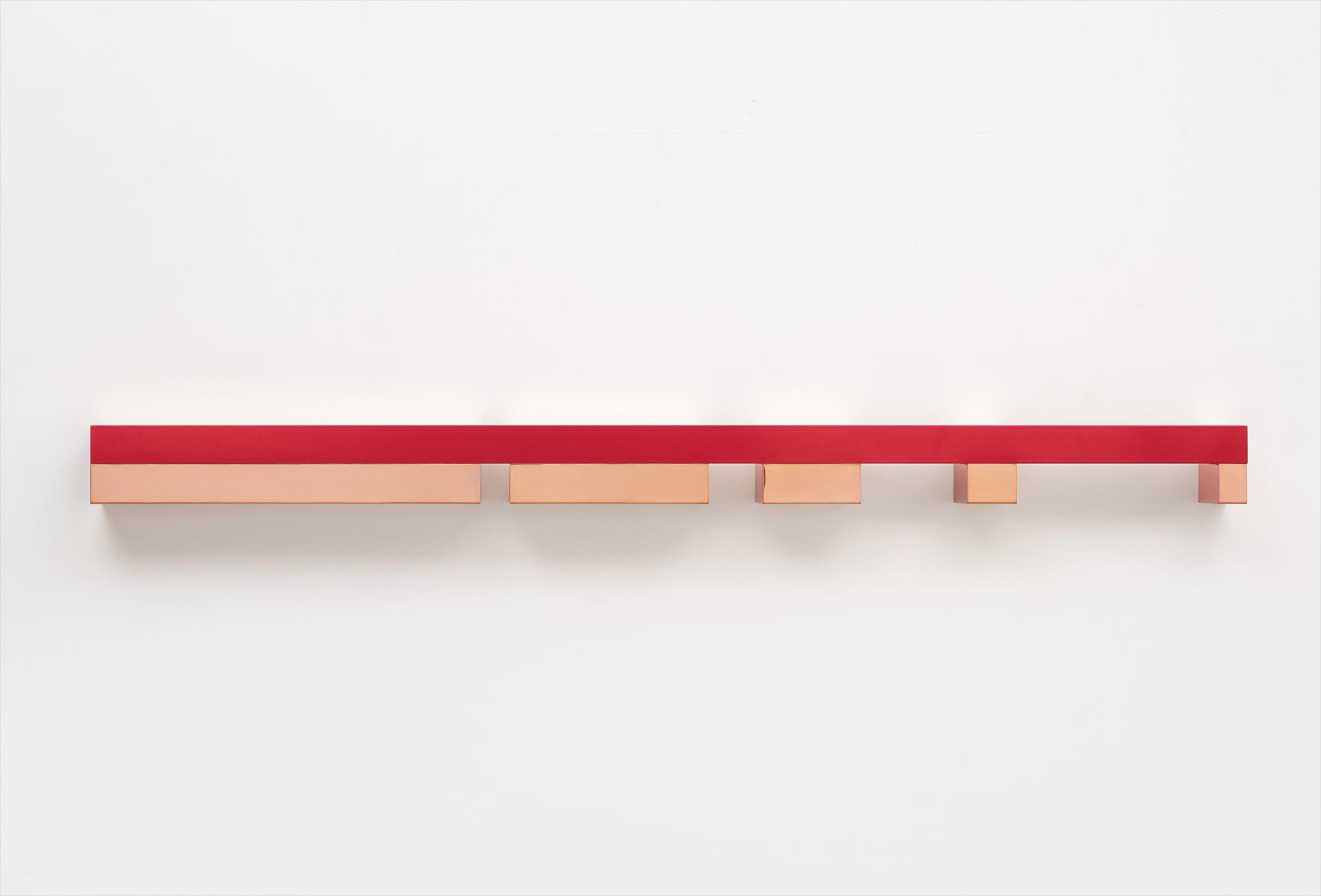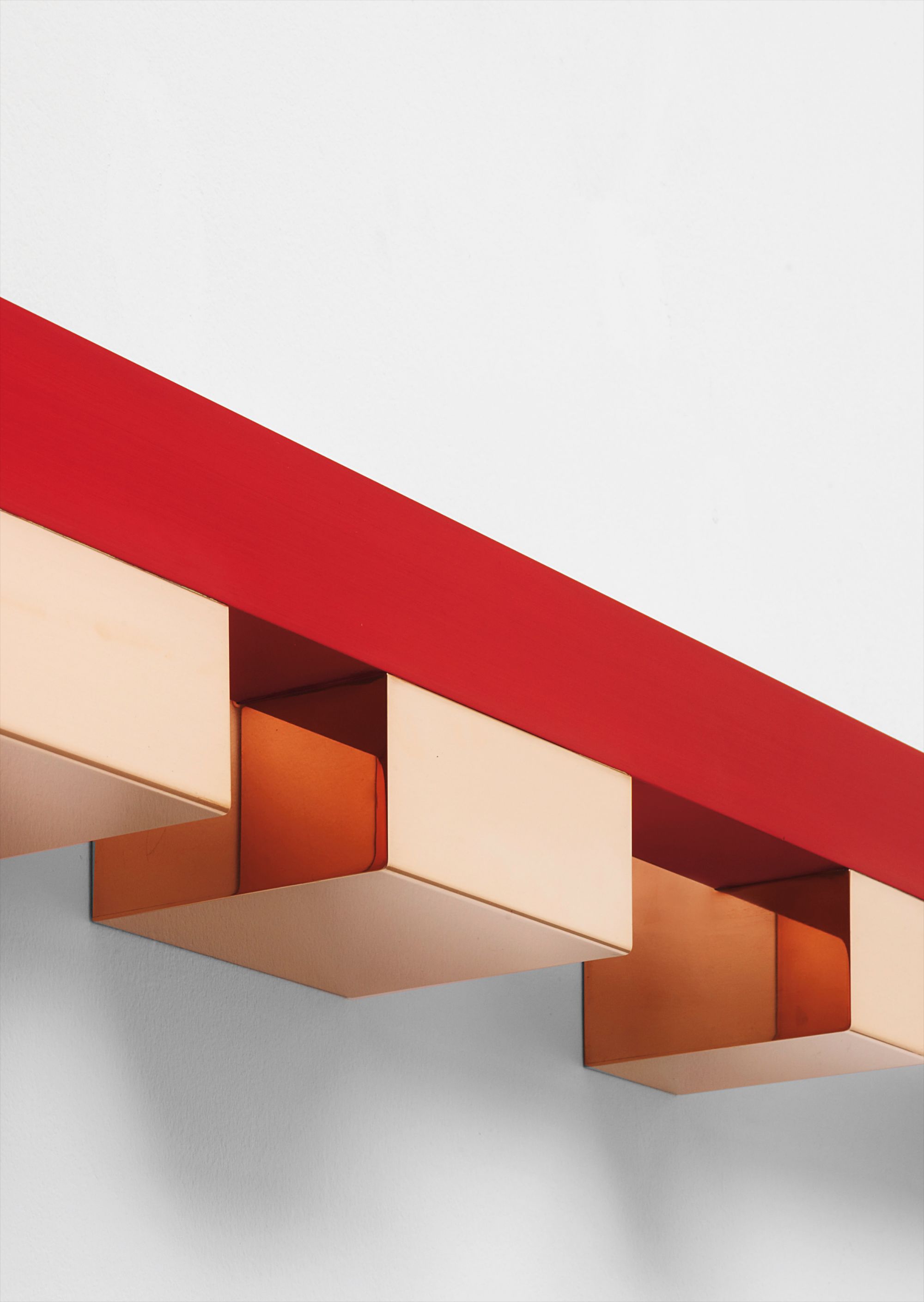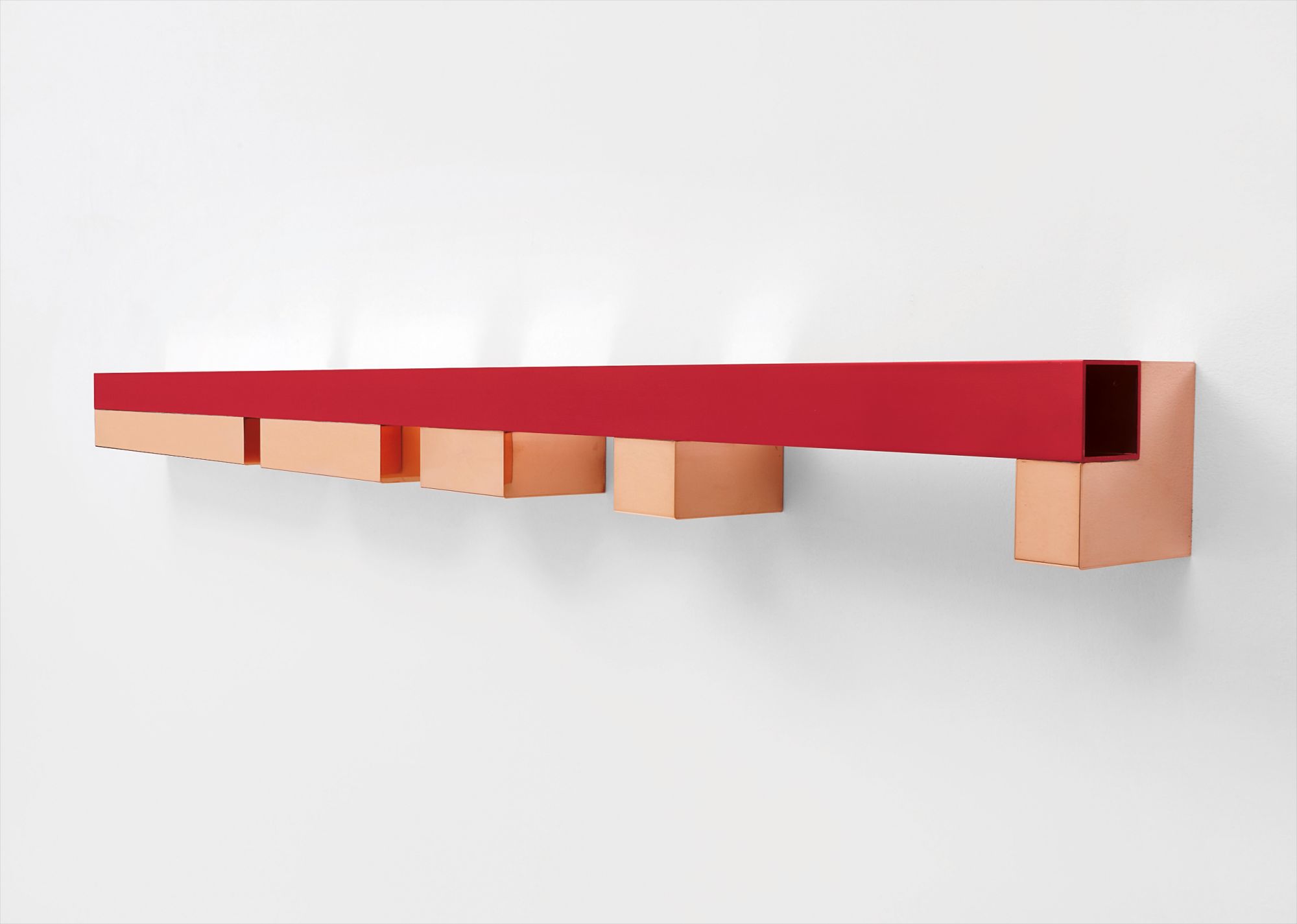





17
Donald Judd
Untitled (79-35)
Full-Cataloguing
DONALD JUDD, 1994
Exceeding the abilities of a mere sculptor, Donald Judd did not transform his materials into new and abstracted objects; rather, the artist transforms the reality that exists around him and his art. As an architect of space, Judd’s execution of Untitled, 1979 in his trademark cadmium red anodized aluminum encourages a holistic restructuring of the environment in which it is displayed and energizes the wall upon which it hangs. Although its consolidation of a stringent geometrical scheme and a highly rational mathematical system remain perhaps the work’s most preliminarily significant and effective aspects, the luminous red and its dynamic transaction with the polished brass besiege viewers in sinews of brilliance. Monumentally immersing the wall in six feet of lustrous color, the individual and repeating modules punctuate the space unevenly as the artist choreographs the space in a rhythmic waltz of fascinating concepts and realized grids. For Judd, the geometric is far more than fact—geometry is also immune to sensitivity and it is the antonym of emotion, and in this regard, his sculptures are the pure antithesis of the primordial sculpture - the human body. Remarkable in his attempts to obscure any sign of his own hand, Judd has produced a singular and extraordinary object, fully self-determining.
It seems impossible to consider, but Judd did not realize his now-exalted masterful wielding of materials until the close of the 1950s, having spent well over a decade discovering and cultivating his craft with largely fruitless forays into painting. Upon investigating the comparatively untapped potential of aluminum, Judd revolutionized sculpture with his unconventional principles, scintillating color, and elementary geometric forms in abstruse arrangements that wholly eclipsed the physical material. Untitled, 1979 is comprised of rectangular structures that widen contrarily to the empty spaces. The mathematical principle guiding the work is that of the Fibonacci sequence, an organic, numerical progression that dictates the corresponding growth of rectangular voids. As each new gap equates the sum of the previous two, the solid forms expand and shrink, almost as if the sculpture clamors for new breaths. Through his utilization of a mathematical formula to govern the structure, Judd has translated an abstract concept into in a visual sensation, and in the process, embodied it as a material in its own right. As the artist once prophetically wrote, “I think that I developed space as a main aspect of art.” (D. Judd, “Some aspects of color in general and red and black in particular,” ed. Dietmar Elger, Germany, p. 81)
The ability of Untitled, 1979 to employ its audience’s mind is a myriad of efforts coalescing, but no two are more integral than that of form and color. Indeed the repetition of form cannot solely support the massive concepts purported by the work-the brush between methodical organization and luscious coloration represents a critical element in the artist’s oeuvre, elegantly conspicuous in the present lot. The anodized aluminum radiates from its red hue and the brass glows golden, but when the two elements are so tightly juxtaposed, their reciprocity propels them to illuminate color fields that are stellar and impossible to replicate when operating independently. Though the color is mechanically fabricated, it materializes as gently lit by the sun’s rays, and it is returned to its rightful range amidst the ready-made and organic spectrum found in nature. The synthesis of the intense hues impresses upon its viewer the artist’s intimate engagement with color and his charge to invert the painterly myth. Color is born of a planar objectivity in the present lot, and Judd’s deliberate choice of cadmium red is markedly instrumental in the definition of space. Of the color cadmium red, the artist has said, “I like the quality of cadmium red light...If you paint something black or any dark color, you can't tell what its edges are like. If you paint it white, it seems small and purist. And red, other than a gray of that value, seems to be the only color that really makes an object sharp and defines its contours and angles." (J. Coplans, “An Interview with Don Judd,” Artforum, vol. 9:10, June 1971, p. 43) As with Judd’s other sculptures, the work is a miniature concatenation, flourishing and thriving as it stretches earnestly along the wall.
Although frequently labeled as the champion of Minimalism, Judd unequivocally refuted this classification, and Untitled, 1979 is a visual testament to his transcendence of any one category. Perhaps the artist’s project is more aligned with that of the geometric abstraction of such artists as Ad Reinhardt, Frank Stella, and Barnett Newman, dramatically breaking from the Abstract Expressionism prevalent in his era. Even still, the immaculacy of color, space, and structure communicated through industrial materials in the present lot can be ascertained as the straightforward expression of logical concepts. Furthermore, the sheer quality of the forethought and the careful deliberation required of the mathematical principles exercised in the work are a triumph, especially when considering the offhand decisions commonly made by artists in their ever-changing and organic processes. Arresting in the vigor of its self-efficacy and chromatic intensity, Untitled, 1979 elucidates that which is both most central and most primitive to Judd.
Donald Judd
American | B. 1928 D. 1994Donald Judd came to critical acclaim in the 1960s with his simple, yet revolutionary, three-dimensional floor and wall objects made from new industrial materials, such as anodized aluminum, plywood and Plexiglas, which had no precedent in the visual arts. His oeuvre is characterized by the central constitutive elements of color, material and space. Rejecting the illusionism of painting and seeking an aesthetic freed from metaphorical associations, Judd sought to explore the relationship between art object, viewer and surrounding space with his so-called "specific objects." From the outset of his three-decade-long career, Judd delegated the fabrication to specialized technicians. Though associated with the minimalist movement, Judd did not wish to confine his practice to this categorization.
Inspired by architecture, the artist also designed and produced his own furniture, predominantly in wood, and eventually hired a diverse team of carpenters late in his career.